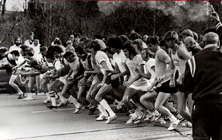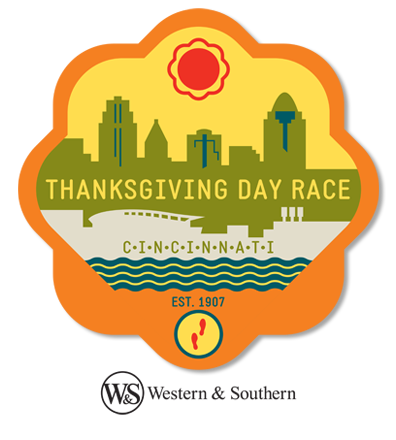The Thanksgiving Day 10K Race History
 N
N
ine decades of running before feast.
by Barry M. Horstman, Cincinnati Post,
originally published November 22, 2000.
Any list of Thanksgiving traditions starts with turkey. Toss in football, the Macy's Parade and the official kickoff to Christmas shopping season.
And in Greater Cincinnati, add one unusual ingredient to the recipe: a Thanksgiving Day race that sends runners streaming through the streets of Northern Kentucky and downtown Cincinnati.
More than nine decades after 18 runners raced from the Fort Thomas Gym to the YMCA in downtown Cincinnati, the Thanksgiving Day race - the oldest road race of any kind in the Midwest - has become an integral part of the holiday for the thousands who run it annually and the thousands more who cheer them along the 10-kilometer (6.2 miles) course.
"For some reason, in Cincinnati, Thanksgiving tradition involves putting on a minimum amount of clothing, going outside in any kind of weather and then running about six miles - and no one questions it," said race promoter and former Olympic marathoner Julie Isphording. From its modest beginning, the race - which one year had fewer than 10 entrants - has grown steadily in recent years. In 1999, a record 6,196 runners and walkers took to the streets.
What gives the race its unusually rich heritage is the emotional hold it has on those who run in it, luring many back year after year. Many runners have competed in 20, 30 or more Thanksgiving Day races, which draw old high school or college track teams back for annual reunions, families who run together and others who apparently feel that a brisk six-mile-plus run is the perfect way to work up a good appetite for their turkey dinner later in the day.
"For many runners, it's become a big part of the holiday," said Don Wahle of Montgomery, who ran in his first Thanksgiving Day race in 1949 and has competed in more than 30 since, including some when he served as race director in the 1960s.
This year, 69-year-old Wahle will be running again, hoping to average about nine minutes per mile, a pace that could place him among the top finishers in his age group. "It's such an addicting race," said Ms. Isphording, whose six victories are the most ever among women.
Started in 1908, Greater Cincinnati's turkey day run is the sixth oldest race in America, behind only the Boston Marathon and a handful of other nearly century-old events, according to Runner's World Magazine.
This 2001 race is the 92nd in its history, interrupted only in 1918, when World War I intervened, and 1936, when management problems caused the race to miss a year.
The event's origins - and, in particular, the choice of Thanksgiving Day - are a bit hazy even to long-time race organizers. Some say the race was started by the downtown YMCA under the provisions of its charter. Others suggest that a few local runners simply decided to organize a race one year, chose a holiday when most people would be off work - and never imagined that it still would be going strong in the 21st century.
Part of the impetus, however, may well have been American marathoner Johnny Hayes' stunning gold-medal victory in the 1908 Olympic Games in London. Much as the next American gold medal in the marathon - Frank Shorter's win 64 years later in the 1972 Munich Games - ignited a running craze in the United States, so, too, did Hayes' triumph elevate public interest in long-distance road races.
Eighteen of the 21 runners entered in 1908 finished the seven-mile course, led by Lovell Draper of Cincinnati, who completed the distance in 37 minutes and 15 seconds, about three minutes ahead of his nearest competitor.
"At the finish he was as fresh as if he had taken a stroll along some shady lane," The Post wrote. "He ran the last 500 yards as fast as some 100-yard dash men do and came in laughing." Draper's first remark upon crossing the finish line was: "I wish it was 10 miles further."
Draper went on to win the first five Thanksgiving Day races, setting the all-time record.
Unlike that horrible high school history, the Thanksgiving Day Race history is outrageously fun. We highly recommend that your training program include some reading!
From the event's first step in 1908 with a few men in skippy shorts, to the misstep in 1924 when the whole race came to a complete halt for a passing streetcar, to the first women's step in 1970, to an Olympic step—four runners became Olympians, to a heroic step when a 16 year old saved a man's life at mile 5.
There are over 100 fast stories compiled by our race historian and turkey day runner himself, Jim Pleshinger.
Step Here & Step Right Into History
